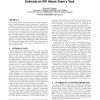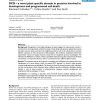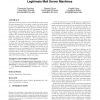199 search results - page 17 / 40 » Developing an Immunity to Spam |
CEAS
2006
Springer
13 years 11 months ago
2006
Springer
ISPs operate "abuse" teams to deal with reports of inappropriate email being sent by their customers. Currently, the majority of this work is dealing with insecure syste...
BMCBI
2005
13 years 7 months ago
2005
Background: Recognition of microbial pathogens by plants triggers the hypersensitive reaction, a common form of programmed cell death in plants. These dying cells generate signals...
BMCBI
2007
13 years 7 months ago
2007
Background: In an epitope-based vaccine setting, the use of conserved epitopes would be expected to provide broader protection across multiple strains, or even species, than epito...
CEAS
2011
Springer
12 years 7 months ago
2011
Springer
Spamming botnets present a critical challenge in the control of spam messages due to the sheer volume and wide spread of the botnet members. In this paper we advocate the approach...
CEAS
2007
Springer
14 years 1 months ago
2007
Springer
To evade blacklisting, the vast majority of spam email is sent from exploited MTAs (i.e., botnets) and with forged “From” addresses. In response, the anti-spam community has d...



